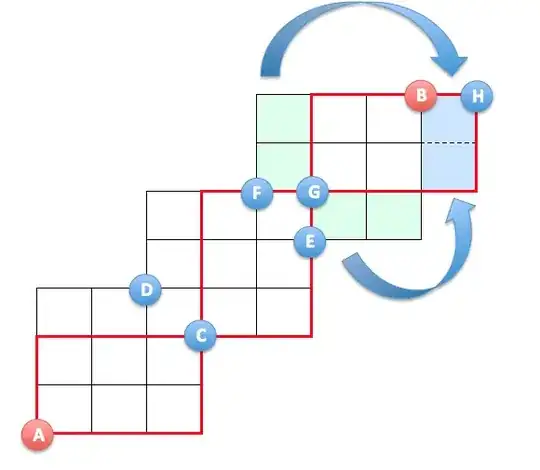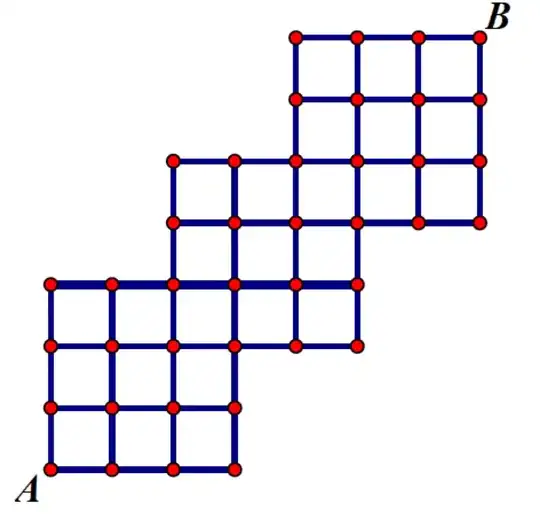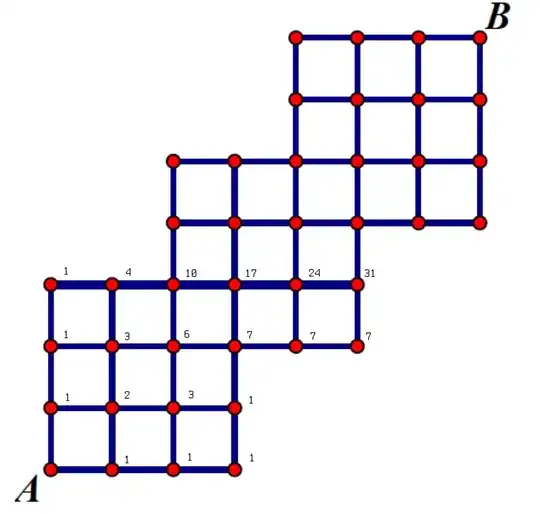$\hspace{2cm}$
Refer to the diagram above.
Denote $\vec{XY}_Z$ as the number of ways to move from point $X$ to point $Y$ moving through optional point $Z$.
We want to find $\vec{AB}$.
First we consider the number of paths through $C$, i.e. $\vec{AB}_C$. The problem can be simplified by superimposing several $2\times 3$ hexominoes (shown in red) on the original and extended lattice.
$\vec{AB}_C$ can be computed as a product of several subpaths as follows (* indicates multiply):
$$\vec{AB}_C=\vec{AC}*\left[\vec{CE}* \vec{EB}+\vec{CF}*\vec{FB}\right]$$
Note that
$\vec{CE}+\vec{CF}=\vec{CG}$ (by symmetry and also because $G$ is one step away from $E,F$) and
$\vec{FB}=\vec{EB}=\vec{GH}$ (moving green squares to blue squares on lattice extension).
Hence
$$\vec{AB}_C=\vec{AC}*[(\vec{CE}+\vec{CF})*\vec{GH}]=\vec{AC}*\vec{CG}*\vec{GH}=\binom 52^3$$
By symmetry along diagonal $AB$, it is obvious that $\vec{AB}_D=\vec{AB}_C$. A similar but orthogonal set of hexominoes can be drawn for $\vec{AB}_D$.
Hence the total number of paths from $A$ to $B$ is given as
$$\vec{AB}=\vec{AB}_C+\vec{AB}_D=\color{red}{2\binom 52^3=2000}$$
General Case
For a similar configuration of $3$ lattices each of dimension $n\times n$ and overlapping by one square along a common diagonal, the number of paths from the lowest leftmost point to the highest rightmost point is given by
$$2\binom {2n-1}{n-1} ^3$$
It can also be shown that for a similar configuration of $m$ attices each of dimension $n\times n$ and overlapping by one square along a common diagonal, the number of paths from the lowest leftmost point to the highest rightmost point is given by
$$2\binom {2n-1}{n-1} ^m$$
 I started off by listing some paths that will get me to $B$. I started listing them off...\begin{align*} & \text{UUURRUURRUURRR}\\ & \text{UUURRRUURUURRR}\\ & \text{UURRUUURRURRRU}\\\vdots\end{align*}
Soon, I realized that this was a simple counting problem. So I got$$\binom{14}{7}=\text{Some large number greater than 2000}$$
But the answer was exactly $2000$. Where did I go wrong?
I started off by listing some paths that will get me to $B$. I started listing them off...\begin{align*} & \text{UUURRUURRUURRR}\\ & \text{UUURRRUURUURRR}\\ & \text{UURRUUURRURRRU}\\\vdots\end{align*}
Soon, I realized that this was a simple counting problem. So I got$$\binom{14}{7}=\text{Some large number greater than 2000}$$
But the answer was exactly $2000$. Where did I go wrong?
